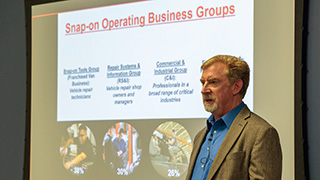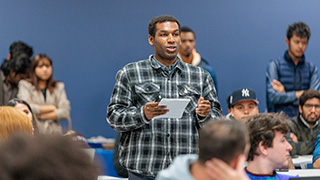Snap-On Tools: Risks In International Supply Chain
Thursday, February 22, 2024

As Head of World Wide Strategic Sourcing for Snap-On Inc., Patrick Healy presented information about the company, plus covered challenges and advancements within the international supply chain arena.
On Halloween night, the Association of Supply Chain Management’s Seton Hall student chapter hosted Patrick Healy, head of World Wide Strategic Sourcing for Snap-On Incorporated. Snap-On is a leading global innovator, manufacturer and marketer of tools, equipment, diagnostics, repair information and systems solutions for professional users performing critical tasks including those working in vehicle repair, aerospace, the military, natural resources, and manufacturing. Healy first discussed the history of Snap-On and their position in the tool manufacturing market. He then explored developments and risks in the international supply chain. Healy ended the event by taking questions from the audience.
The first portion of the event covered Snap-On’s history and current standing in the market. He explained that the concept of the company began in 1920 when an engineer from Milwaukee named Joseph Johnson came up with the concept of having five unique handles and ten sockets that snapped interchangeably. This simple idea drove Snap-On to become the premier tool manufacturer in the nation. Today, Snap-On is a fortune 500 company that is not only growing its revenue, which totaled 4.25 billion in fiscal year ending September 2023, but also its operating income, proving that the company is still improving its efficiency every year.

Healy presented to packed crowd in Walsh Library on Halloween.
Snap-On is broken into four main groups. First, the Snap-On tools group which Healy described as the company’s "bread and butter." This is the group that sells tools in their signature franchised mobile stores. These mobile stores are essentially vans operated by franchisees that travel to customers and sell their signature tools. The second group is called repair systems. Healy described this group’s specialty as not only physical products, but "unique productivity solutions." The third group within Snap-On is the commercial and industrial group. This group specifically creates tools used by professionals whose price of failure is very high, for example the military or oil and gas. The fourth and final group is the financial services group. Where the first group was the "bread and butter," Healy described this group as the "special sauce." This group provides loans to clients who need the Snap-On products and tools to make a living, but do not have the financial means to purchase them outright and would not have the credit to take out a traditional loan. Through this group, Snap-On supports and lifts up individuals in and around the manufacturing industry.
Healy shared an example of these groups in action through one of their specific products, car repair collision diagnostic systems. Snap-On’s diagnostic systems allow the mechanic to test the issue and tap into millions of previously reported similar issues to allow the mechanic to find common solutions and order required parts immediately. And, since cars are built from the inside out but repaired from the outside in, the repair can use specially made Snap-On tools to make the installation process easier. Since mechanics get paid by the job and not the hour, Snap-On can help mechanics maximize their man hours. This example just exemplified the love that Snap-On’s customers have for the products they sell. Healy highlighted this love and respect through customer’s willingness to get tattoos with the Snap-On logo and the free marketing that the appearance of the company’s tools in blockbuster movies like Ironman and Transformers provides.

Healy illustrated how the four operating business groups within Snap-on operate using specific product examples.
Healy then began to touch on some current issues and risks to be aware of in the global supply chain. He identified four main causes of concern; currency fluctuation, geo-political risks, environmental risks, and logistics issues. First, to Healy, currency fluctuations have forced finance concepts to get shoehorned into sourcing and supply chains. The fluctuations of up to 8% in the previous few years have forced sourcing professionals to consider these factors to ensure they are optimizing costs. Second, he brought up an array of examples from the past few years that inform geo-political risks. One of these examples, which he mentioned during the Q&A session as being what keeps him up at night, is Taiwan. He thinks that it wouldn’t take an armed invasion to affect supply chains out of Taiwan as China will simply need to cut off water routes. This ease and the timebomb political tensions represent a significant risk to everything from computer chips to battery markets. The third risk he brings up is environmental risks. Healy brings up extreme heat, lake level lowering and hurricanes affecting supply chains around the globe. Lastly, Healy elaborates on how the interconnectedness of logistics makes every mistake a major hassle. As an example, he brings up famous examples such as the blocked Suez Canal to the widespread labor strikes of this past year.
What is Healy’s answer to mitigating these risks? Well, Healy explains that the easiest way to mitigate risks is by diverse sourcing. Specifically, a concept called Dual Sourcing, or the sourcing from two separate suppliers. Healy further explains that dual sourcing now means dual regions, meaning that suppliers a firm purchase from can now no longer be in the same region. A company aiming to stay ahead must make these international considerations. Healy brings up the advantages and disadvantages of different regions of the world. He explored the advantages and disadvantages of China, Vietnam, Thailand, India, Costa Rica, and the Dominican Republic. He notes that it is also important to traverse and switch between all these regions as situations shift as time goes on. Lastly, Healy then talked about strategies for setting up a firm’s Dual Sourcing distribution. He sees three general options. He says that 80/20 is the worst of the three since the secondary supplier cannot absorb primary supplier volume if need be and the set up tends to make limited number of SKUs. He then explained that while a 50/50 split is good, it doesn’t introduce as productive of competition between the two suppliers as 60/40. He believes this because this distribution introduces competition with clear rewards and puts pressure on the supplier with 60% to keep the advantage while dangling the majority in front of the 40% supplier as a constant motivation.

The audience of students, faculty and guests from other universities posed challenging and insightful questions.
The final portion of the talk was Healy taking questions from the audience. The audience had a lot of great questions. One of these questions had to do with 3-D printing and its impact on Snap-Ons business. Healy explained that 3-D printing has really helped Snap-On’s innovation. It allows an inventor of a tool to be able to describe the tool, receive back a model from the Snap-On engineers within a few weeks, confirm the design and immediately begin production. This allows Snap-On to get specialized tools in the hands of professionals as quickly as possible. Another interesting question had to do with the UAW strikes and their effect on Snap-On and its customers. Healy answered that the strikes will bleed down to smaller businesses since they will lose people to plants. He contended that everyone in manufacturing will have to raise their wages because as one component goes up it rises all wages.
Overall, this was an extremely informative event. Events like this, which are regularly put on by the ASCM club, are essential in helping Stillman students connect with professionals in the industry to understand current industry trends.
This article originally appeared in The Stillman Exchange, the official business publication of Seton Hall University.
Categories: Business






